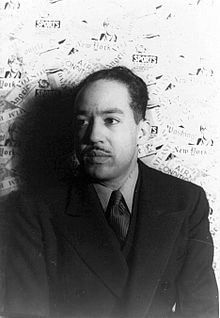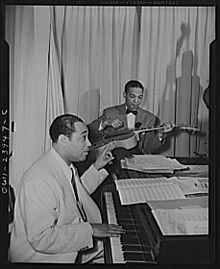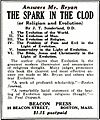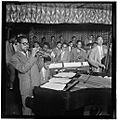Harlem Renaissance facts for kids
The Harlem Renaissance is the name for a movement in African-American culture in the 1920s and 1930s which has had a big influence on African-American literature, philosophy and music. The Harlem Renaissance is also called the "Black Literary Renaissance", '"The New Negro Movement" and "The flowering of Negro literature".
The movement began in Harlem, New York after World War I. In 1925 a book was published called "The New Negro", edited by Alain Locke. This book was a collection of writing by African-Americans which looked at their people's lives and experiences since the Civil War. From 1925 onwards, there was a movement called the "New Negro Movement", named after the book.
The movement began to affect the thinking of many African-American writers and artists of all sorts. They challenged the thinking of many white Americans towards black Americans. They refused to be treated as if they were not equal. They refused to just copy the sorts of writing, art and music that white Americans did. They wanted to celebrate the fact that their African culture had survived through the terrible years of slavery, and was being "reborn". (The word "Renaissance" means "rebirth" and is generally used for a time from 1400 to 1600 in Europe.)
Contents
Important writers and musicians of the Harlem Renaissance
Novels
- Jessie Redmon Fauset – There is Confusion (1924), Plum Bun (1928), The Chinaberry Tree (1931), Comedy, American Style (1933)
- Rudolph Fisher – The Walls of Jericho (1928), The Conjure Man Dies (1932)
- Langston Hughes – Not Without Laughter (1930)
- Zora Neale Hurston – Jonah's Gourd Vine (1934), Their Eyes Were Watching God (1937)
- Nella Larsen – Quicksand (1928), Passing (1929)
- Claude McKay – Home to Harlem (1927), Banjo (1929), Gingertown (1931), Banana Bottom (1933)
- George Schuyler – Black No More (1930), Slaves Today (1931)
- Wallace Thurman – The Blacker the Berry (1929), Infants of the Spring (1932), Interne (1932)
- Jean Toomer – Cane (1923)
- Eric Walrond – Tropic Death (1926)
- Walter White – The Fire in the Flint (1924), Flight (1926)
Drama
- Charles Gilpin, actor
- Eugene O'Neill, playwright–Emperor Jones, All God's Chillun Got Wings
- Paul Robeson
Poetry
- Langston Hughes, poet
- Jessie Fauset, editor, poet, essayist and novelist
- Countee Cullen, poet – The Black Christ and Other Poems (1929)
- Claude McKay, poet
- James Weldon Johnson, poet
- Arna Bontemps, poet
- Richard Bruce Nugent, poet
Musicians/Composers
- Nora Douglas Holt Ray
- Billie Holiday
- Duke Ellington
- Count Basie
- Louis Armstrong
- Eubie Blake
- Bessie Smith
- Fats Waller
- Aretha Franklin
- Ella Fitzgerald
Popular entertainment
- Cotton Club
- Apollo Theater
- Black Swan Records
- Small's Paradise
- Connie's Inn
- Speakeasies
- Rent party
Images for kids
-
The multi-talented Adelaide Hall and Bill 'Bojangles' Robinson in the musical comedy Brown Buddies on Broadway, 1930
-
Trumpeter Dizzy Gillespie is emblematic of the mixture of high class society, popular art, and virtuosity of jazz.
-
Langston Hughes, communist novelist and poet, photographed by Carl Van Vechten, 1936
See also
 In Spanish: Renacimiento de Harlem para niños
In Spanish: Renacimiento de Harlem para niños









